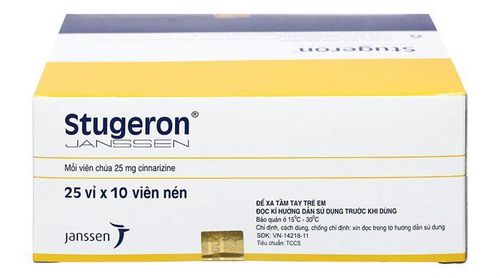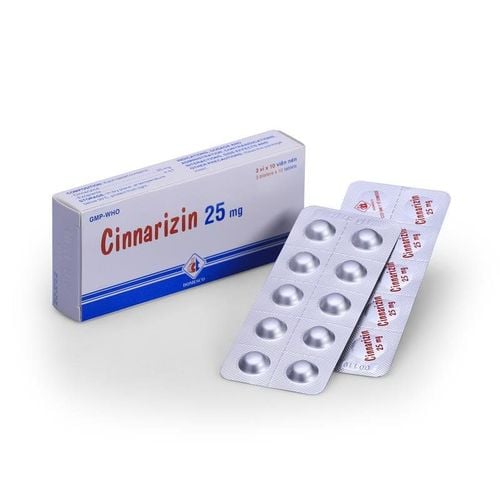This is an automatically translated article.
Vestibular disorders are common diseases in adulthood, the disease causes fatigue, which greatly affects health and life. Through the vestibular examination tests will detect the disease and help treat the disease in time.1. Dizziness based examination test
Dizziness is the main symptom of vestibular disorders:
The patient has a feeling of being displaced, everything around rotates, or the patient himself rotates compared to the surrounding objects. In obvious cases, the sensation of displacement is very pronounced, which can occur in the vertical or horizontal plane. However, in some cases of vertigo that is not obvious, the patient only has a sensation of shifting or swaying the body, or a feeling of the body going up, down, or a feeling of loss of balance. Signs of vestibular disorders are often:
Patients often feel fear, discomfort, loss of balance Falls can occur when dizzy, at this time the patient cannot stand. Disturbance of gait in some cases

Bệnh nhân bị rối loạn tiền đình thường có cảm giác sợ hãi,khó chịu
Possible nausea, vomiting appear when doing light movements and are often accompanied by vasomotor disorders such as pale skin, sweating, decreased heart rate Dizziness due to vestibular disorders is divided into 2 types :
Physiological dizziness: Due to motion sickness, altitude, neck position... Pathological vertigo: Visual dizziness, dizziness due to depth perception disorder, dizziness due to dysfunction vestibule ...
2. Test based on symptoms of nystagmus
Nystagmus caused by vestibular disorders often beats in rhythm. It is a rhythmic eyeball movement consisting of a succession of two phases: The slow phase moves the eyeball to one side (due to the effects of the vestibular system), followed by the fast phase moves the eyeball in the opposite direction, bringing the eyeball to one side. eyes to the resting position (due to the action of the pontine reticulum).
When there are symptoms of nystagmus, we need to determine its direction and direction.
Direction: Vestibular nystagmus is named in the direction of rapidity because this direction is best seen on physical examination. It can be horizontal, vertical, or circular nystagmus (clockwise or counterclockwise), or mixed (horizontal-circular) nystagmus. Direction: Right, left for transverse nystagmus, up, down for longitudinal nystagmus, clockwise or counterclockwise for circular nystagmus. Degree of nystagmus:
Grade I: Presence of nystagmus with the same direction as the side where the eye glances to that side. Grade II: Nystagmus occurs even when the eye is in the midline. Grade III: The nystagmus swings in the opposite direction to the direction the eye is turned to.
3. Test based on symptoms of balance disorder

Rung giật nhãn cầu do nguyên nhân rối loạn tiền đình thường đánh theo nhịp
Static disorders: Pay attention to the displacement of the trunk, the body axis, this displacement is in the direction of the endolymph flow.
Romberg's sign: When the patient is standing with the legs closed, the patient's torso should be tilted to one side, rarely forward or backward, but usually the same side for a patient. This disturbance increases when the patient's eyes are closed (Vestibular Romberg's sign). In more severe cases, the patient may fall, sometimes suddenly, at which point standing and walking becomes impracticable. Walking test: The patient walks on a point for one minute, arms straight out in front of him, knees bent and legs raised, if necessary let the patient count at the same time to avoid concentration, if any Vestibular lesions patients will begin to rotate their axis in a particular direction, more than 45 degrees in 50 steps is pathological vestibular disorders. Two-arms straight test: Patient is in an upright position, eyes are closed, hands are extended straight forward, two index fingers are aimed at the examiner's two corresponding index fingers, we note that there is a slow movement on the face. horizontal plane in the direction of the affected vestibule for peripheral vestibular pathology. Dysmothorax: displacement of extremities in the direction of endolymphatic flow
Star-walking test: Ask the patient to close his or her eyes, take 5 steps forward, then 5 steps back, repeat several times about 30 seconds. If the vestibular function is decreased on one side, the patient tends to deviate to one side (diseased side) when advancing and deviating in the opposite direction when moving backward, drawing a star shape. Past pointing test: The patient raises his arms straight out in front, touches the examiner's index finger with his index finger, then asks the patient to close his eyes, raise and lower his hand to touch the examiner's hand again. For people with vestibular disorders, the two index fingers do not touch the examiner's hand but move to one side, we record that deviation. The more times you do it, the more the angle of displacement can increase. During the examination, always pay attention to the direction of the deviation direction, the direction of the arm deviation and the slow direction of the nystagmus to see if there is compatibility, harmony or not.
4. Heat test
The heat test is an easy test to perform, which helps us assess the functioning of each individual vestibular organ.
Have the patient lie on his or her back, head elevated at a 30-degree angle, and hold the lateral semicircular canal in an upright position. Pump into the patient's ear with cold water of 33 degrees or hot water of 44 degrees for about 40 seconds, the minimum time between two tests is 5 minutes, warm water is less irritating than cold water. Be sure to check for damage to the tympanic membrane prior to heat testing (tympanic membrane perforation is contraindicated). In patients with normal vestibule, cold water stimulation produces nystagmus with a slow direction towards the ear and a rapid direction in the opposite direction. In patients with one-sided vestibular disorders: The stimulation without nystagmus, or the presence of slow nystagmus, has a weaker amplitude and shorter duration than the healthy side.
5. Revolving chair test

Nghiệm pháp ghế quay dùng để khảo sát chức năng tiền đình hai bên ở những bệnh nhân bị điếc hoàn toàn
Have the patient sit in a revolving chair with the head tilted forward at a 30 degree angle, rotate the chair 10 times for 20 seconds, then stop, observe the reactions appear. If the direction of rotation of the chair is to the right, then after stopping the rotation, the patient has nystagmus, swinging sideways to the left, when standing, falling to the left, the finger deviates to the left.
Usually this test is used to investigate bilateral vestibular function in patients with complete deafness.
6. Nylen-Bárány . test
When a patient has benign postural vertigo, this maneuver is intended to increase symptoms.
Let the patient sit with his head turned to the right, quickly put the patient in supine position 30 degrees lower than the horizontal plane, observe for nystagmus and dizziness. Then bring the patient to sit up, the head should continue to be kept in the rotating position, to observe if the patient has dizziness and nystagmus. The test is repeated with the head and eyes turned to the left lying down and looking straight down. In addition, there must be more neurological examination to see if the patient has damage to the VIII hearing, VII, V, cerebellar lesions, and motor and sensory lesions.
Above are vestibular examination tests to help diagnose vestibular disorders accurately and effectively. From there, giving appropriate treatment regimens to help patients recover quickly.
Vinmec International General Hospital with a system of modern facilities, medical equipment and a team of experts and doctors with many years of experience in medical examination and treatment, patients can rest assured to visit. examination and treatment at the Hospital.
Please dial HOTLINE for more information or register for an appointment HERE. Download MyVinmec app to make appointments faster and to manage your bookings easily.
Reference source: webmd.com
MORE
Vestibular disorders in the elderly are easily overlooked Beware of vestibular disorders due to cervical spondylosis Treat vestibular dysfunction













